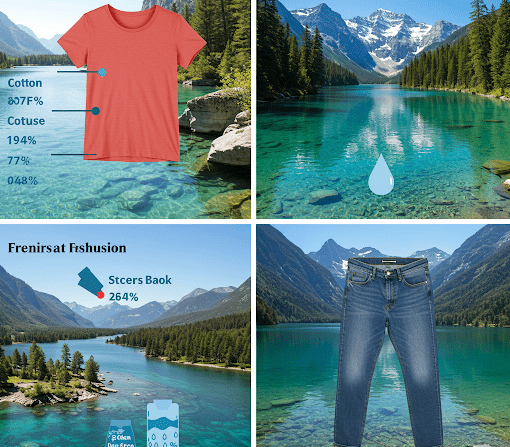The Hidden Thirst of Our Wardrobes: Why Water is a Major Cost of Clothing
We often think about the price tag when we buy clothes, considering the cost of materials, labor, and brand markup. But there’s a hidden cost woven into the fabric of our garments – the immense amount of water required to produce them. From the cotton fields to the dye vats, water plays a crucial role in the lifecycle of our clothing, making it a significant, often unseen, expense for the planet.

The fashion industry is a thirsty giant, consuming an estimated 93 billion cubic meters of water annually. To put that into perspective, that’s enough to fill a large lake or meet the drinking water needs of a substantial population for years. This massive consumption contributes significantly to water scarcity, especially in regions where raw materials like cotton are grown and where textile processing takes place.
The Water Footprint of Our Favorite Fabrics
Different fabrics have vastly different water footprints:
- Cotton: This widely used natural fiber is notoriously water-intensive. It can take around 2,700 liters of water to produce just one cotton t-shirt. This includes the water needed for irrigation, as well as the water used in processing and dyeing the cotton.
- Denim: Your favorite pair of jeans? It could have a water footprint of around 7,600 liters. The cultivation of cotton and the numerous washes required to achieve the desired look contribute to this high figure.
- Synthetic Fabrics (Polyester, Nylon): While the growing of these fibers doesn’t require irrigation, their production is energy-intensive and relies on fossil fuels. Washing synthetic clothes also releases microplastics into our waterways, contributing to another form of water pollution.
- Linen and Hemp: These natural fibers generally have a lower water footprint compared to conventional cotton, as they often require less irrigation and fewer pesticides.
- Organic Cotton: Choosing organic cotton can significantly reduce the water footprint compared to conventional cotton, as it often relies on rainwater and avoids the use of harmful chemicals that can pollute water sources.
The Environmental Impact: Beyond Consumption
The water used in clothing production doesn’t just disappear. The textile industry is a major source of water pollution. Dyeing and finishing processes use numerous chemicals, and the resulting wastewater, often untreated, is discharged into rivers and lakes. This contamination harms aquatic ecosystems and can impact the health of communities that rely on these water sources.
Furthermore, the pesticides and fertilizers used in conventional cotton farming can leach into the soil and water, causing further environmental damage.
What Can Be Done? Towards a More Sustainable Wardrobe
Recognizing the significant water cost of our clothing is the first step towards change. Here are some ways the fashion industry and consumers can reduce this impact:
For the Fashion Industry:
- Sustainable Material Choices: Prioritizing materials with lower water footprints like organic cotton, linen, hemp, and recycled fibers.
- Water-Efficient Production Techniques: Investing in technologies like air dyeing, supercritical CO2 dyeing, and closed-loop water systems that recycle and reuse water.
- Eco-Friendly Dyes and Finishes: Using non-toxic dyes and minimizing the use of harmful chemicals in processing.
- Water Reduction in Manufacturing: Implementing techniques to reduce water flow, reuse wash water, and optimize washing cycles.
- Rainwater Harvesting: Utilizing rainwater as a supplementary water source in production facilities.
- Smart Water Management: Employing sensors and data analytics to monitor and optimize water usage.
For Consumers:
- Choose Sustainable Materials: Opt for clothing made from organic cotton, recycled materials, and other low-impact fibers.
- Buy Less, Choose Well: Investing in high-quality, durable garments reduces the need for frequent purchases.
- Wash Clothes Less Often: Over-washing contributes to water and energy consumption and releases microplastics from synthetic fabrics.
- Wash in Cold Water: Cold water washing saves energy and can be just as effective for most loads.
- Consider Second-hand Clothing: Buying pre-owned clothes gives garments a longer lifespan and reduces the demand for new production.
- Support Brands with Sustainable Practices: Look for companies transparent about their water usage and environmental impact.
Conclusion
The next time you reach for a new item of clothing, take a moment to consider its hidden water footprint. By understanding the true cost of our fashion choices, we can all play a part in promoting more sustainable practices and protecting our planet’s precious water resources. The journey towards a more sustainable wardrobe requires a collective effort from the industry and consumers alike, ensuring that style doesn’t come at the expense of our environment.
